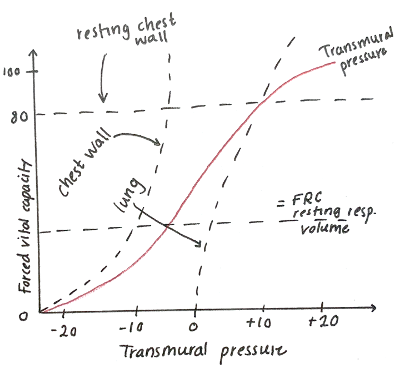We can use spirometry to measure some key volumes of the lungs:
- Tidal volume = volume of air breathed in and out of the lungs during quiet breathing (500ml)
- Inspiratory reserve volume = the maximal volume that can be inhaled from the end-inspiratory level

- Expiratory reserve volume = describes the maximal volume of air that can be further exhaled subsequent to the volume achieved at the end of the exhalation phase of quiet breathing
- Residual volume (RV) = the volume of air left in the lungs following expiration of the expiratory reserve volume i.e. the maximal exhalation capacity
- Inspiratory capacity = the combination of the inspiratory reserve volume and the tidal volume
- Functional residual capacity = is the residual volume of air in the lungs plus the expiratory reserve volume i.e. the air remaining in the lungs after the expiration phase of a quiet breath
- Vital capacity (VC) = the volume of air that can be inhaled after a maximum exhalation.
- Total lung capacity = is the combined total of residual volume and vital capacity and therefore represents the largest volume of air that can be in the lungs at any one time
Compliance
The volume of air in the lungs depends on the elasticity of lung/chest wall and resistance to air flow.
Compliance = the change in volume of the lung as one changes the pressure = change in volume/change pressure
At functional residual capacity, the opposing forces of elastic recoil of the chest wall and the lungs are in equilibrium. This maintains the shape of the lungs and ensures that the lungs are expanded.
Lung compliance depends on:
–> elasticity of the lung parenchyma
–> surface tension of air-liquid interface
Chest wall compliance depends on:
–> rigidity/shape of thoracic cage
–> chest wall muscles.

If the compliance is decreased, then it means a greater transmural pressure is needed to cause changes in volume.
– Therefore, this means the lungs struggle to expand, which decreases functional residual capacity and vital capacity.
Surfactant
One of the key things which decreases the compliance of the lungs is surfactant:
– Surfactant reduces the surface tension to increase compliance and reduce work of breathing
– This keeps alveoli dry –lower surface tension means water is not pulled into the interstitial space
– Allows alveoli of different sizes to exist- ensuring smaller alveoli do not collapse

